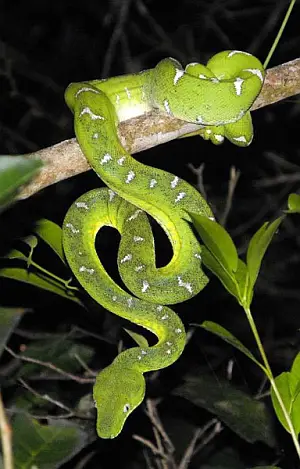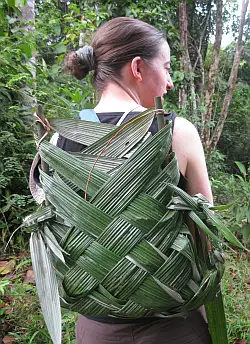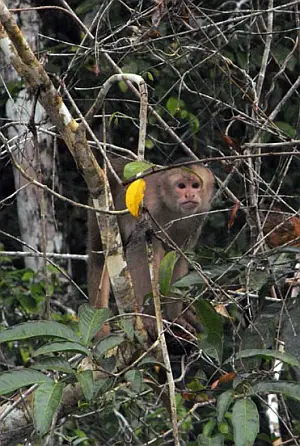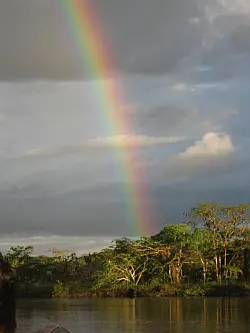Coming to Terms with Downpours, Bugs, and Visiting Creatures—Page 2
By Lea Aschkenas

When Luis points out his first sighting, a reddish-brown tarantula dangling almost delicately from a tree branch just a few inches from our youngest tour member, a teenage girl who has been nursing an infected spider bite, I feel myself silently cringing with her as she quickly moves away.
"Honey," her mother says, "I'm sure he's more afraid of you than you are of him."
"I doubt it," the girl snaps back as I stifle a laugh. I can't help but feel a sense of solidarity with this teenager, my fellow malcontent.
But as the morning wears on, something begins to shift for me. Despite my initial irritation with the rain and the humidity, the mosquitoes and the mud, I find myself enchanted with Luis' reverence for and knowledge of the natural world that surrounds him, for the patience he has in weathering the sporadic downpours of our walk, in waiting for the forest to reveal itself to him.
Luis tells us of a medicinal or utilitarian purpose for each plant we pass. He shows us berries that are used for insect repellant; mushrooms that cure ear infections; a tree whose prickly air roots can grate cassava, which in turn can be used as flatbread flour or, when mixed with water, a moisturizing facial mask. Luis points out cinchona trees, whose bark contains the quinine used to treat malaria; and another tree's leaves, which double as carbon paper (for leaving directional notes in the jungle) when pressed against a tree trunk and written on with a stick.
There are trees harvested for their contraceptive qualities and others for their diarrhea-countering sap. There is a palm whose oil prevents hair loss and whose fronds house a fiber woven to make rope. And then there are the vines—hallucinogenic vines like the notorious ayahuasca, hat and basket-making vines, and giant philodendron vines  strong enough to swing us through the jungle Tarzan-like.
strong enough to swing us through the jungle Tarzan-like.
At the end of our walk, Luis pulls out his pocket knife.
"Until I first left the jungle as a teenager, I'd never seen one of these," he says. "For cutting, we used to use the teeth of the piranha we fished for."
With that introduction, Luis slashes off two thick branches of an overhanging palm. As I look on with the others, awestruck at his adeptness, Luis weaves the palm fronds into a thatch pack and then cuts a thin but unbreakable vine to serve as two straps.
"Ve Lea," he calls out, motioning me over when he finishes. He asks me to turn around and lift my arms, and then he slides his handiwork over my shoulders and onto my back.
"In the Amazon, we use this to carry what we've hunted," he says, "but for you, it can be a fashionable jungle backpack."
As the other travelers pull out their cameras, I smile and pose, not even thinking about the critters that might be crawling through my pack's fronds.
Soldiering On
On my fourth day in the Amazon, during a rare rain-free afternoon canoe glide, Luis uses his hunter's eye to show us the animals that surround us but whose presence we fail to detect on our own. He points out a brown and white baby-faced capuchin monkey hovering in a branch next to my head. A small stretch down the river, he raises his right hand to silence our chatter so that we look eagerly around for a new animal to add to our growing list: iridescent blue morpho butterflies, noisy crowned hoatzin birds, and even a near-extinct scarlet macaw.

In a hushed voice, Luis says, "I'm going to count to three and then I want all of you, as loud as you can, to shout, 'March! March! March!'"
Once we do so, the silence is miraculously broken by the sound of, yes, stomping feet, which appear to resonate from an invisible army in the rainforest. We sit in stunned silence until Luis points to an oblong nest high in a tree along the shore. He tells us that the wasps that live here have a symbiotic relationship with a family of ants who swarm around them protectively when the wasps alert them to an approaching presence via a frantic wing-flapping that sounds remarkably similar to stomping.
To celebrate our last night in the Amazon, we go on a nighttime jungle walk during which Luis shows us more variety of ants than I've ever known to exist, including leaf-cutter, lemon (used to season food), and perfume (rubbed onto the bodies of hunters to disguise their scent) ants. He identifies boa snakes draped in low-hanging branches above our heads by the red glow of their eyes against his flashlight, and he shows us the bright colorings of a poison dart frog. He explains how oil from the frog's skin (toxic only when it enters directly into the bloodstream) is painted on the darts of blow guns so that an animal dies immediately when it's shot rather than limping about the forest in pain.
I think about how everything here works together, serving both itself and the other. Unlike my first night's frog-spotting, I now stare calmly at the creature before me. I stand still, not even moving when I feel the first drops of this evening's storm.

The Urban Jungle
On my way home, I have a day layover in Cuenca, a big city in the south of Ecuador. As I wait for my scrambled egg in my hostel's kitchen at breakfast, I notice the owner looking out into the lush courtyard and, still on a high from my time in the Amazon, I mistake the gleam in her eyes for a look of admiration, not unlike the one Luis wore whenever we stepped outside the lodge.
"What are you looking at?" I ask.
"A big spider," she says. "A tarantula!"
"Really, where?" I ask excitedly. I stand up to join the owner at the door, but before I get there, she adds, "I can't stand spiders, especially not near my kitchen."
With one swift sweep of her broom, she knocks the stunned tarantula from his tree-side resting spot and then quickly orders the maid, "Fast, get me the spray!"
The owner steps outside and squirts a toxic aerosol concoction onto the tarantula. Then, coughing at the fumes, she quickly steps back inside and slams shut the door.
I am, I realize with more sadness than I would have ever imagined at the start of my trip, not in the Amazon anymore.

Lea Aschkenas is the author of Es Cuba: Life and Love on an Illegal Island.
Wildlife photos courtesy of Siona Lodge. All others by the author.
Related stories:
Message en una Botella by Lea Aschkenas
Humble in the Jungle: Exploring Guyana's Rainforest by Laurie Gough
Tranquilandia Transformed in Colombia by Richard McColl
Where is the Where? Hiking to the Horizon in Iceland by Lea Aschkenas
See other South America travel stories from the archives
Copyright (C) Perceptive Travel 2013. All rights reserved.
- Going Where No Roads Go in Ontario by Carolyn B. Heller
- Alert in the Americas: Inside the Farms Growing Our Coffee by Tim Leffel
- World Music Reviews
- Travel Book Reviews
Books from the Author:

Buy Es Cuba at your local bookstore, or get it online here:
Amazon US
Amazon Canada
Amazon UK

